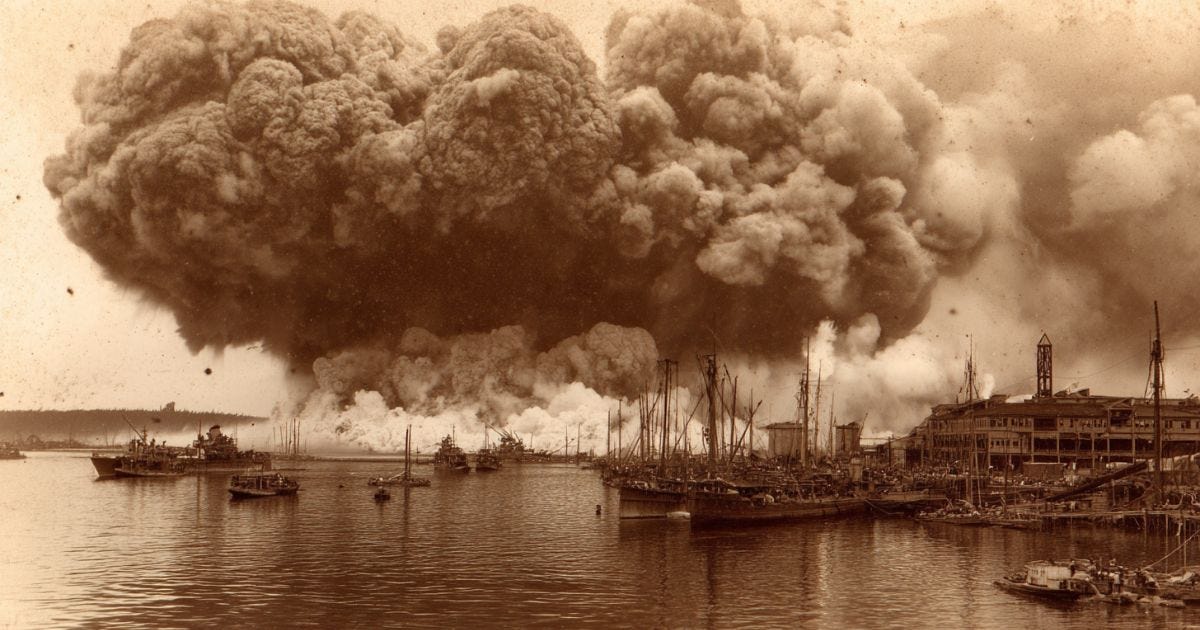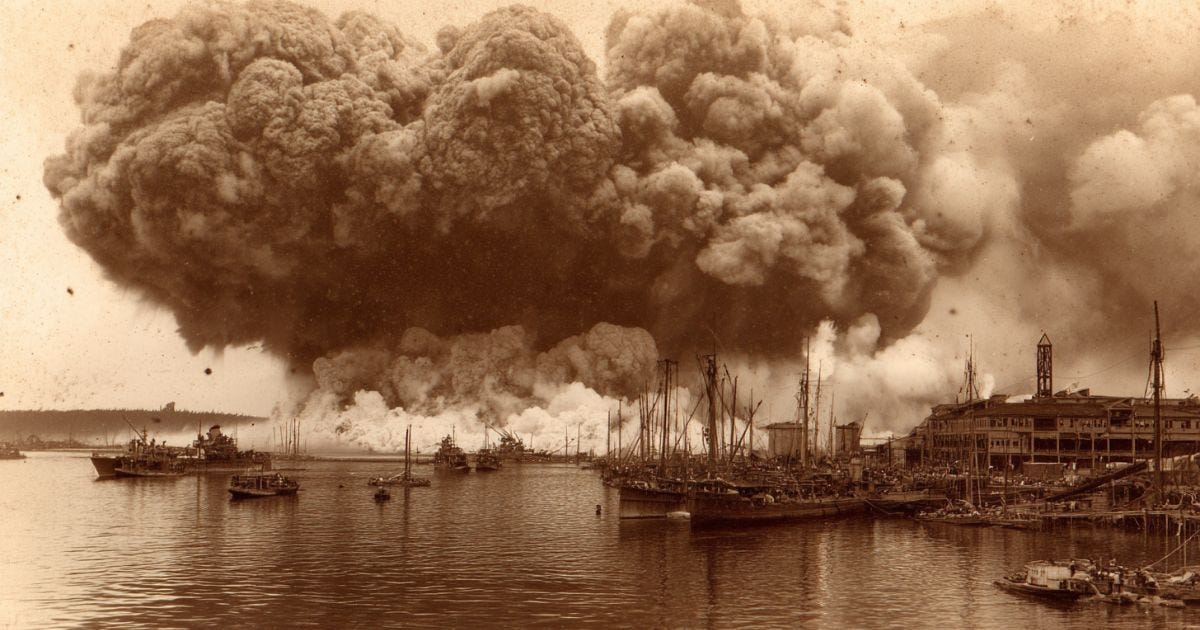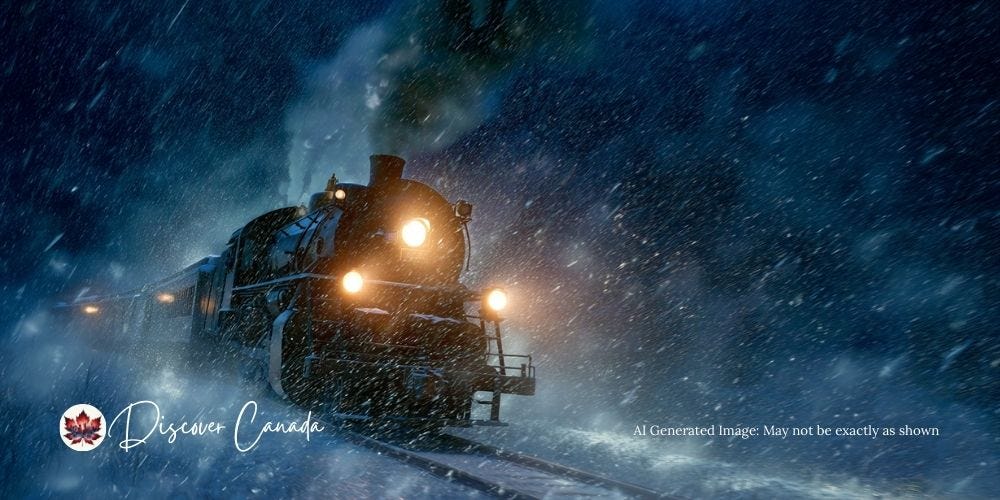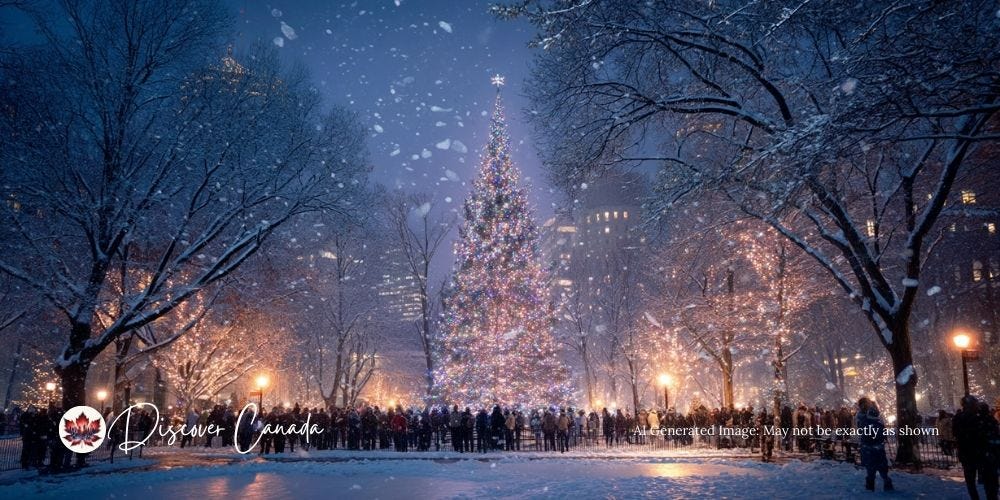🌲 From Ashes to Evergreens: Halifax’s Thank-You to Boston
How a tragedy sparked a century of kindness
🎧 Listen While You Read
Hit play and let the audio carry you back to Halifax, 1917, while you explore this story of tragedy, resilience, and cross-border kindness.
It was just after 9 a.m. on a cold December morning when Halifax Harbour erupted with a blinding flash, brighter than the sun. In a matter of seconds, the city was torn apart — homes flattened, windows shattered for miles, and thousands of lives forever changed. This was the Halifax Explosion of 1917, the largest man-made blast in history before Hiroshima.
✨ Key Takeaways
⚡ The Halifax Explosion was the largest man-made blast before Hiroshima.
🚂 Boston rushed aid across the border within 24 hours, through a fierce winter storm.
🎄 Nova Scotia’s annual Christmas tree gift to Boston keeps the gratitude alive.
🤝 A timeless reminder that Canada and the U.S. stand together in times of crisis.
🌆 A Morning Shattered in Halifax
⚓ The Collision in the Harbour
On the morning of December 6, 1917, the busy waters of Halifax Harbour bustled as usual. Ships moved in and out of port, carrying war supplies, relief cargo, and everyday goods. But one vessel, the French munitions ship Mont-Blanc, had something far more dangerous — over 2,500 tons of explosives bound for Europe’s battlefields.
As the ship maneuvered through the Narrows, it collided with the Norwegian vessel Imo. The impact seemed small at first, just a crunch of steel against steel. But sparks flew, fire caught, and within minutes, smoke poured from the deck of the Mont-Blanc. Dockworkers and children gathered to watch, unaware they were staring at a floating powder keg.
💥 The Explosion’s Fury
At 9:04 a.m., the Mont-Blanc erupted with a force no one could imagine. The blast ripped through Halifax, levelling buildings within a half-mile radius. A shockwave shattered windows 50 miles away. A fireball soared nearly two miles into the sky. And a tsunami, triggered by the sheer force of the detonation, swept the waterfront.
The numbers still stagger: 2,000 dead, 9,000 injured, 25,000 left homeless. Entire families vanished in an instant. Streets were littered with splintered wood, glass, and the echoes of silence that follow catastrophe. Survivors spoke of being thrown through the air, of roofs collapsing, of a city transformed into rubble in the blink of an eye.
Halifax, once a thriving port city, now looked like a battlefield — but with no soldiers in sight.
But from the smoke and ruins, a story of humanity emerged. News of the disaster reached across the border, and within a single day, Boston — bound to Nova Scotia by family, history, and shared seas — sent trains filled with doctors, nurses, and supplies, braving a blizzard to bring hope to a devastated city. And from that act of kindness grew a tradition that still shines each December.
🏚️ A City in Ruins
💔 The Human Toll
In the hours after the blast, Halifax was a city of confusion and grief. Streets that once bustled with children heading to school and workers on their way to the docks were now littered with debris and silence. Over 2,000 lives were lost, and thousands more were injured — some blinded by flying glass, others pinned beneath collapsed buildings.
The devastation was so complete that survivors often spoke of not recognizing their own neighbourhoods. Wooden homes were splintered like matchsticks. Churches and schools collapsed into rubble. Families searching for loved ones found only fragments of what had been.
🦸 Acts of Survival and Courage
And yet, amid the wreckage, heroism stirred. Neighbours pulled one another from the ruins with their bare hands. Teachers shielded children as ceilings caved in. Doctors and nurses, many of them injured themselves, worked tirelessly in makeshift hospitals, treating the wounded without rest.
Ordinary citizens became first responders — comforting strangers, bandaging wounds with scraps of cloth, and offering shelter to anyone who had lost a home. In a city broken beyond recognition, the strength of community became Halifax’s lifeline.
Still, the need was overwhelming. Supplies ran thin, doctors were exhausted, and the dead far outnumbered the living’s ability to bury them. Halifax needed help — and that help was already on its way, from across the border.
🚂 Boston Hears the News
📣 The Call for Help
When word of the explosion reached New England, the news spread with shocking speed. Telegraphs carried the grim reports south: an entire Canadian city in ruins, thousands dead, countless injured. In Boston, the reaction was immediate. Many families in Massachusetts had roots in Nova Scotia — fishermen, labourers, and migrants who had crossed the border in search of work. Halifax was not a distant city; it was kin.
Leaders in Boston wasted no time. Within hours, the Massachusetts governor had authorized a full relief effort. Doctors, nurses, and emergency supplies were gathered. Volunteers stepped forward, many with no idea what awaited them, only a certainty that they had to go.
❄️ Trains Through the Blizzard
By nightfall on December 6, trains packed with medical teams and carloads of supplies were racing north. The journey was brutal — a fierce winter storm raged, snow piling on the tracks, winds battering the cars. Yet nothing stopped them.
When the first Boston train pulled into Halifax the following morning, it carried not just bandages and medicine but a wave of compassion. Doctors rushed straight to overwhelmed hospitals. Nurses stepped into operating rooms where the wounded lay shoulder-to-shoulder. Food, blankets, and volunteers poured into neighbourhoods that only the day before had been flattened.
For Halifax, this wasn’t just relief. It was hope — arriving on steel rails through snow and ice, from neighbours who had crossed a border without hesitation.
🎄 More Than Relief — A Lasting Bond
🌟 A Christmas Tree of Gratitude
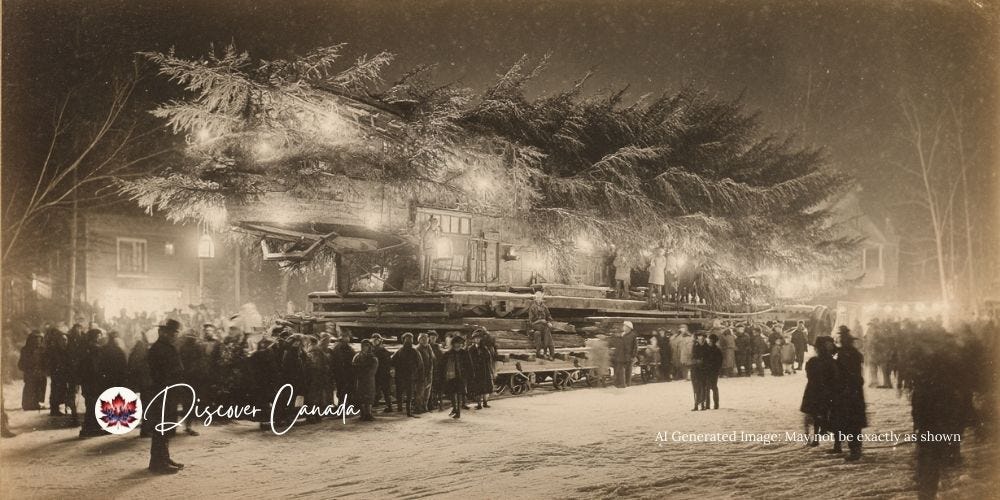
In the wake of the explosion, Nova Scotians never forgot Boston’s kindness. Just one year later, in 1918, Halifax sent a towering Christmas tree to the city as a gesture of gratitude. Decorated with care, it stood as a symbol of light after darkness, a way of saying: we remember who came to our aid when we needed it most.
The tradition faded for a time but was revived in 1971, and every year since, Nova Scotia has carefully selected a massive spruce and sent it south. Today, that tree still takes its place on Boston Common each December, lit by thousands of bulbs and watched by crowds who may not all know the story — but feel the warmth of its glow.
🤝 A Century of Friendship
The Halifax Explosion forged more than a relief mission; it cemented a bond between neighbours. In the century since, Canada and the United States have stood by each other in moments of crisis — from world wars to natural disasters, from 9/11 to wildfires.
The annual Christmas tree serves as more than a decoration. It is a reminder that, even across borders, compassion travels quickly. A city once reduced to rubble now sends light to another, proof that kindness, once given, multiplies across generations.
💡 Pro Tip
✨ If you ever see Boston’s Christmas tree glowing in December, remember it’s more than festive lights — it’s a century-old thank-you note from Nova Scotia, written in evergreen branches.
🔚 Conclusion
The Halifax Explosion of 1917 began as one of Canada’s darkest mornings — a blinding flash, a city in ruins, and thousands of lives cut short. But from that devastation rose an enduring story of compassion: trains from Boston racing through a blizzard, doctors and nurses offering comfort to strangers, and a gift of light that still shines each December.
In many ways, it’s a reminder that borders mean little when disaster strikes. What matters is the humanity that flows across them. Halifax’s tragedy became Boston’s mission, and Boston’s kindness became Halifax’s lasting gratitude.
More than a century later, as the Christmas tree lights flicker on Boston Common, they carry a message that still matters: neighbours help neighbours, no matter the distance.



